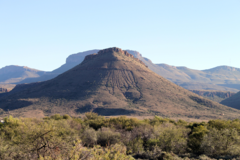| Teekloof Formation | |
|---|---|
| Stratigraphic range: Middle Permian ~ | |
 | |
| Type | Geological formation |
| Unit of | Adelaide Subgroup, Beaufort Group |
| Overlies | Abrahamskraal Formation |
| Thickness | up to 300 m (980 ft) |
| Lithology | |
| Primary | Mudstone, siltstone |
| Other | Sandstone |
| Location | |
| Coordinates | 32°56′56″S 25°48′58″E / 32.949°S 25.816°E |
| Approximate paleocoordinates | 60°00′S 32°36′W / 60.0°S 32.6°W |
| Region | Western, Northern & Eastern Cape |
| Country | |
| Type section | |
| Named for | Teekloof Pass |
 | |
The Teekloof Formation is a geological formation that forms part of the Beaufort Group, one of the five geological groups that comprises the Karoo Supergroup in South Africa. The Teekloof Formation is the uppermost formation of Adelaide Subgroup deposits West of 24ºE and contains Middle to Late Permian-aged (Guadalupian to Lopingian) deposits and four biozones (Pristerognathus, Tropidostoma, Cistecephalus, and Daptocephalus assemblage zones) of the Beaufort Group.[1][2] It overlies the Abrahamskraal Formation (the western correlate of the Middleton Formation). The Teekloof Formation does not underlie other units other than the younger Karoo dolerites and sills that relate to the emplacement of the Early Jurassic Drakensberg Group to the east.[3] Outcrops and exposures of the Teekloof Formation range from Sutherland through the mountain escarpments between Fraserburg and Beaufort West. The northernmost localities of the Teekloof Formation are found by Loxton, Victoria West and Richmond.[4]
- ^ Keyser, A. W., and Smith, R. M. H. (1978). Vertebrate biozonation of the Beaufort Group with special reference to the western Karoo Basin. Geological Survey, Department of Mineral And Energy Affairs, Republic of South Africa.
- ^ Keyser, A. W. (1979). A review of the biostratigraphy of the Beaufort Group in the Karoo Basin of South Africa. Geocongress, Geological Society of South Africa, 2, 13-31.
- ^ Kitching, J. W. (1970). A short review of the Beaufort zoning in South Africa. In Second Gondwana Symposium Proceedings and Papers (Vol. 1, pp. 309-312).
- ^ Rubidge, B. S. (ed.) 1995b. Biostratigraphy of the Beaufort Group (Karoo Supergroup). South African Committee of Stratigraphy. Biostratigraphic Series 1. Pretoria, Council for Geoscience.